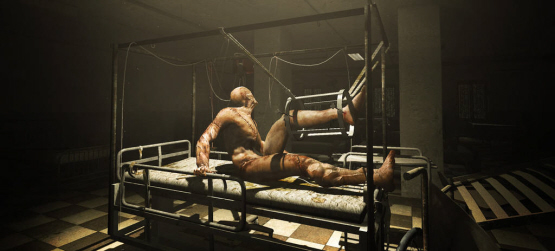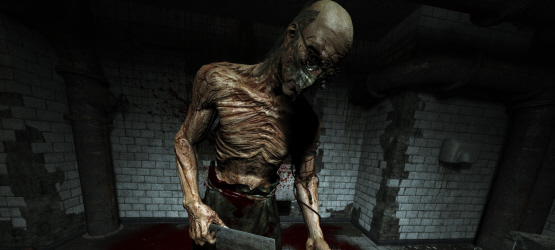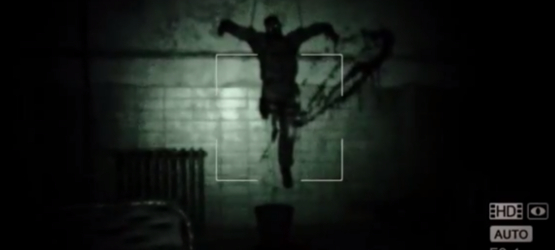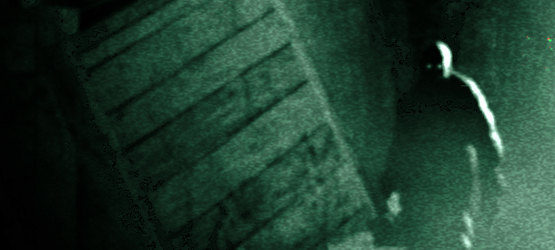
The immediate hook that drew me into Outlast is that Miles Upshur is just a journalist chasing down a mysterious lead. He’s a normal guy. He’s not an action hero. He doesn’t have a stock of guns adorning his body. He can’t even punch. In Outlast, your only options are to run, hide, or die, and you’ll be doing all three quite a bit.
Before I even loaded up the game I made sure that the lights were off and that my surround sound was at a decently terrifying volume. Outlast is still a scary game in the daylight with the sound turned down low, but the true Outlast experience comes when you give up the nice comforts of lighting and reasonable volumes. The opening sequence has you semi-innocently finding your way into the Mount Massive Asylum through an open second story window, just to investigate an anonymous email. It reminded me of my high school days, sneaking into abandoned scary places. It felt more real and grounded to me than many other horror games do, which helped the psychological terror dig into me.
The dark room you stumble into introduces you to the night vision mode on your video camera, which is the only way to see in the dark. There’s no cheating and turning up the brightness here. Unfortunately this has the adverse effect of draining your battery life, and batteries are a rare commodity, especially as you increase in difficulty. This constant hunt for batteries effectively keeps your attention divided. While your thoughts are on what you are possibly going to do when that next pitch black area comes around, you won’t be expecting the figure that runs across the hall ahead of you or that suddenly grabs you from behind. The lightbar on the DualShock 4 is tied to your use of the camera, glowing white when you are in normal camera mode, and changing to a shade of green while you’re in night vision. It will also flicker along with your camera as the batteries die off, which helps to infuse the mood all around a darkened room.

Both corpses and the living insane inhabit the halls of Mount Massive, with each new encounter wearing on the sanity of Miles. The ambiance of Outlast is what truly drives it to terrifying heights. The music is not over-relied on to convey a sense of fear, as some horror games have a tendency to do. It is a well placed background to the circumstances and never foreshadows too much or feels like too little. The lighting is also well done, not revealing too much, and throwing shadows to really make you wonder if that particular hallway or room is safe to traverse or not. The atmosphere chips further into the psychological terror with what the inhabiting crazies say and do. Not everyone in the asylum is an enemy, but I wouldn’t call them friends either. Even that guy sitting in the corner can have the psychological effect of furthering the fear, without ever looking up at you. Small details like the bloody footprints left when walking through a pool of blood, or Miles’ hand reaching up to the wall as he approaches doorways and corners are just a few more touches that help sell the ambiance of Outlast. The one spark of ambiance that deeply affected my playthrough, however, was Miles’ breathing.
That’s right, breathing. The breathing effects in Outlast are some of the best in any video game ever, and I’m not even being sarcastic or facetious. I often wondered if Miles had tapped directly into my emotions. The pace of his breathing quickened when I turned a corner to see a mutilated corpse, or a watched a shadowy figure disappear into a door on the other side of a room. While hiding in lockers from things that wanted nothing more than to see my insides on the outside, I feared that his panicked breathing would give me away, and I would try to hold my own breath to stop him from making a sound. Time and time again, my overall Outlast experience came down to the incredible work that was simply done with when and how much to make a guy breathe.

Anyone privileged enough to be playing this on a surround sound system is in for a treat. All of these ambient effects are expertly done in 5.1 surround sound, with the echoes of the sounds made in the asylum finding their way to all of your speakers, surrounding you and drawing you deeply into the experience. From rushing water, to chains, to the roars and moans as I was being chased, I felt like I was inside Mount Massive myself. I would highly recommend playing with either a surround system or headphones to get the full intended experience.
Nearing the tail end of Outlast, I found myself feeling a little bit like I was getting used to the scares and ambiance, often leading me to making more reckless decisions to run through areas rather than hiding and sneaking. This is something that seems to happen with all survival horror games as they drag on. Fortunately, Outlast’s relatively short length is a blessing in disguise, as the game concluded before I felt that I got too exhausted of its tricks. Depending on how much running, hiding, and/or dying you do, Outlast will take roughly five hours, which felt like the ideal length without wearing the intrigue too thin.
Outlast comes with the Insane mode, which is the obligatory “one life, no checkpoints, highest difficulty” mode that a lot of horror games are including (notably the Dead Space games). While I felt that I could experiment on my normal playthrough, as death did not have too terrible of a consequence, Insane mode would require me to entirely rework the way in which I played. I would consider Insane mode to be the “true” Outlast experience, with death holding a much heavier consequence. Unfortunately, cloud saving and backing up save files has ruined this for any players that want to circumvent the system and restore old save files rather than playing the way that the developers intended.

Red Barrels seems to have crafted a character and a scenario that feels as real as the player wants to make it. Knowing that you have no way to fight, and a limited ability to see in the dark, affects your thinking within all situations. In addition, Outlast does not rely on jump scares. While there are some of those to be had, Outlast is truly shaped by the ambiance that it creates; by creating believable circumstances and enveloping you in them at a psychological level. Jump scares may have your heart racing for a few seconds, however, creeping across that darkened courtyard with your batteries running out while something out there wants you tortured and dead will have you on edge until the experience ends.
-
Miles' breathing effects.
-
The overall ambiance...
-
...means psychological terror is ever present.
-
Spectacular  surround sound audio.
-
Death has little consequence on lower difficulties.
-
Ambiance began to wear thin near the conclusion.








